Symbolic recombination is the peak of ritual experience, taking place when participants are the most receptive to new ideas. Once their psychological defenses against change have been disabled, ritual participants are ready to undergo metamorphosis. Before they can do so, however, they must be presented with the raw materials from which their identities are to be rebuilt. Symbolic recombination is the means through which this presentation takes place.
Symbolic recombination can best be understood as a cultural analogue to genetic recombination. Both address the same basic challenge: How to balance the need for stability against the need for adaptation to changing conditions.
In biology, genes provide the rules by which the complexity of the physical body is maintained. In culture, symbolic memes provide the rules by which the complexity of a social identity is maintained. As effective as these systems of rules are, they become maladaptive if they are unable to change.

Just as recombination in genetics is the engine of biological innovation, cultural innovation is powered by symbolic recombination. As with genetic recombination, symbolic recombination begins with the division of cultural meanings into their most fundamental parts. These basic symbols are then shuffled, like tarot cards, and brought back together in unexpected ways, creating symbolic chimeras that enable ritual participants to reflect upon the deeper meaning of their situations from a new perspective.
It’s with symbolic recombination that artistic expression, including storytelling, comes to the fore. The purpose of this creative expression to provoke, rather than to please, and so its aesthetic is as likely to provoke horror as it is to inspire delight. To outsiders, the art of ritual may therefore seem grotesque rather than beautiful. What’s more important than a pleasing appearance is that the symbolic work of ritual speaks to the struggle of transformation, a process that often requires sacrifice and pain.